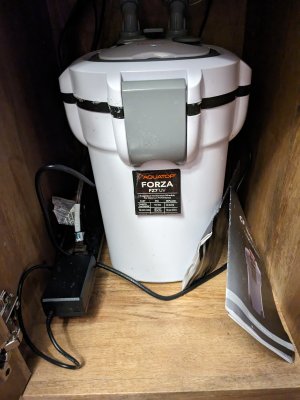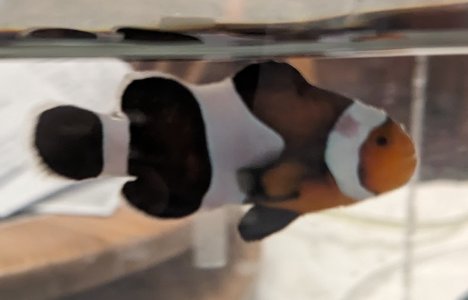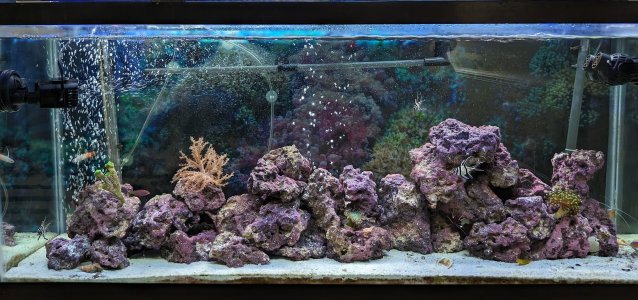I have a 7 month old tank that I have had a close eye on. I have never had ammonia, nitrates, nitrites and PH go out of whack since I have had fish in the tank. I do not do regular water changes but, ensure I keep the salinity in check by adding RO water or Salt treated RO water. I have cleaned the sand bed a few times. I recently cleaned the back wall of the Diatom build up and have started to lose fish.
Tank setup: 55 Gallon with a canister filter, duel head wave maker on one end and a single one on the other. Heater and two aerators. Nearly 100lbs of purple stone. Live sand was used on the bottom.
Fish list: Coral Bueaty, Dotty Back, Sailfin Tang, 3 Cardinals, Tail spot blenny, cleaner blenny, red fire shrimp, peppermint shrimp, 3 hermit crabs, 2 Mocha Clowns, 6 line wrasse, sea anemone
Coral: Trumpet, Green star polyp, frog spawn, and leather coral type
I noticed the Dotty back and Tail spotted blenny were scraping their bodies on the rocks.
Then my Sailfin Tang decided to just lay at the sand bed of the tank. Next morning, nothing left, hermit crabs ate him.
The next day the 2 were still scraping their bodies and the clown fish appeared to be doing some weird jerking movement.
So I scrambled to get a 10 gallon to setup for quarantine and treat the 3 with some Paraguard. This appeared to clear them up after 48hrs as they were not scraping their bodies and the clown was swimming normal.
I put them back in the display tank and 3 days later they started exhibiting symptoms again. I did not want to go through and dismantle the tank to chase the dottyback around again. I was able to capture the Tail spotted blenny and this time I used MetroPlex, but he died the next day with some mold thing growing on his belly. then my Sea Anemone disappeared the next day.
The clown fish (See pic attached, Spot on this head. It cleared up though.) I put back into quarantine cleared up but died the next day. The other clownfish exhibited the same symptoms then died after putting into quarantine.
I checked the water parameters of the quarantine tank and they were the same as the display one.
The cleaner blenny was next to go and I'm at a loss as to what is going on. I've lost probably 30% of the water and had to refill it during this process as I used some of it to put in the quarantine tank.
I did buy a volt meter to check for stray voltage in the tank. That turned up with nothing.
I'm at a loss and just may give up. This is frustrating to lose so much so fast.
Link to video:
two weeks later Video:
Tank setup: 55 Gallon with a canister filter, duel head wave maker on one end and a single one on the other. Heater and two aerators. Nearly 100lbs of purple stone. Live sand was used on the bottom.
Fish list: Coral Bueaty, Dotty Back, Sailfin Tang, 3 Cardinals, Tail spot blenny, cleaner blenny, red fire shrimp, peppermint shrimp, 3 hermit crabs, 2 Mocha Clowns, 6 line wrasse, sea anemone
Coral: Trumpet, Green star polyp, frog spawn, and leather coral type
I noticed the Dotty back and Tail spotted blenny were scraping their bodies on the rocks.
Then my Sailfin Tang decided to just lay at the sand bed of the tank. Next morning, nothing left, hermit crabs ate him.
The next day the 2 were still scraping their bodies and the clown fish appeared to be doing some weird jerking movement.
So I scrambled to get a 10 gallon to setup for quarantine and treat the 3 with some Paraguard. This appeared to clear them up after 48hrs as they were not scraping their bodies and the clown was swimming normal.
I put them back in the display tank and 3 days later they started exhibiting symptoms again. I did not want to go through and dismantle the tank to chase the dottyback around again. I was able to capture the Tail spotted blenny and this time I used MetroPlex, but he died the next day with some mold thing growing on his belly. then my Sea Anemone disappeared the next day.
The clown fish (See pic attached, Spot on this head. It cleared up though.) I put back into quarantine cleared up but died the next day. The other clownfish exhibited the same symptoms then died after putting into quarantine.
I checked the water parameters of the quarantine tank and they were the same as the display one.
The cleaner blenny was next to go and I'm at a loss as to what is going on. I've lost probably 30% of the water and had to refill it during this process as I used some of it to put in the quarantine tank.
I did buy a volt meter to check for stray voltage in the tank. That turned up with nothing.
I'm at a loss and just may give up. This is frustrating to lose so much so fast.
Link to video:
Attachments
Last edited:



